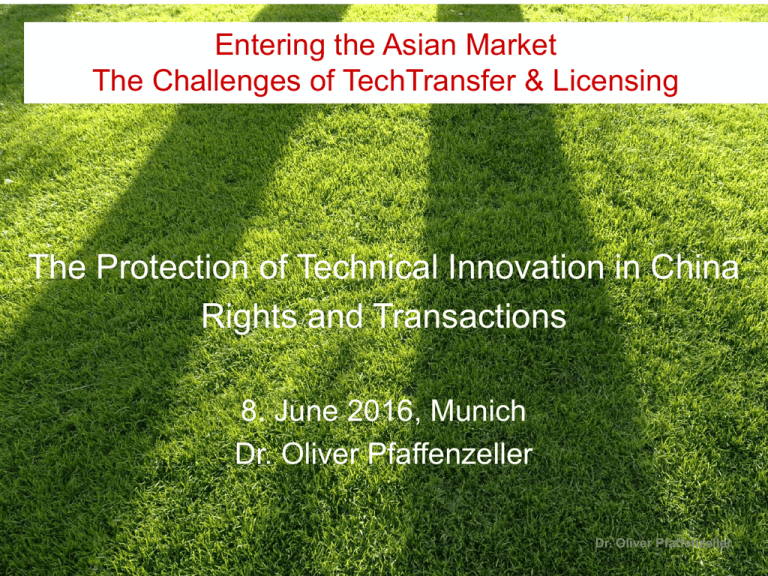The Protection of Technical Innovation in China Rights and
advertisement

EnteringChina thePatents Asian Market 2012 The Challenges of TechTransfer & Licensing The Protection of Technical Innovation in China Rights and Transactions 8. June 2016, Munich Dr. Oliver Pfaffenzeller Dr. Oliver Pfaffenzeller. China and IP Confucius in Analects: „I transmit rather than create; I believe in and love the Ancients“ IP strange to traditional China (except trade secret) Rite (礼) instead of law (法) First efforts to protect intellectual property under late Qing Introduction of modern legal system only after Mao area IP rights as civil rights Patent Law 1984 (amendments 1992, 2000, 2008, 2017 (?)) patents Art. 118 of General Principles of Civil Law (1986) and Art. 10 of Law of Against Unfair Competition (1993) trade secrets IP rights are private rights, but rights sui generis Transactions are mainly governed by Contract Law of China (1999) Creation and ownership of inventions I Art. 2 PL: „Invention-creation“ (发明创造) patents, utility models, designs Art. 6 PL: Invention-creations belong to inventor / creator Art. 6 PL: Service invention-creations belong to employer Service invention-creations i) in performance of tasks (任务) ii) mainly using the material and technical means of employer Draft for 4th amendment point ii) deleted, but can be agreed upon by employer/employee Ownership of inventions based on knowledge acquired by employee (“Erfahrenserfindungen”) ? Creation and ownership of inventions II Art. 12 of Implementing Regulations of Patent law service invention-creations are invention-creations i) in the course of performing one´s duty (本职) ii) in execution of any task, other than the own duty, which was assigned by the employer iii) within one year of termination of employment if invention is related to duty or task of former employment Four drafts for Regulations on Service Inventions (published 2012 – 2015) strengthen position of employee (higher remuneration, more rights) add plant varieties, semiconductor technologies, technical secrets Adoption of regulations was called off – controversy about service invention policy in China Rights relating to patent law Art. 2 PL: „Invention-creation“ (发明创造) basis for: Right to file an application: 申请专利的权利 (= right to invention) Right of application: 专利申请权 Patent Right: 专利权 Joint invention-creations Right to apply for a patent belongs to both parties unless agreed otherwise (Art. 8 PL) joint application of co-owners (ban on double patenting) Contract Law of China (1999) Chapter XVIII „Technology Contracts“, Section II „Technological Development Contracts“ Art. 339 CL: Inventions in commissioned development belong to commissionee unless otherwise agreed by parties Art. 340 CL: Inventions in joint development belong to both parties unless otherwise agreed by parties Ownership Ownership conflicts must be solved in civil litigation; change of ownership is registered on request by SIPO upon submission of court decision Co-owned patent application right or patent right (Art. 15 PL) − Agreements about the exploitation of these rights prevail (recommended way to proceed) − In absence of an agreement it is necessary to obtain co-owner’s consent except for direct exploitation, i.e. • any co-owner may exploit patent alone or grant non-exclusive license • license fee shall be distributed among all co-owners Art. 341 CL: technological development contracts should cover ownership of technical secret (技术秘密) results. If contract is not conclusive both parties have the right to use and transfer the results (commissionnee may transfer only after delivery of results to commissioner) Transfer of technical rights I Chapter 18 CL: Technology contracts (技术合同) Section 3: Technology transfer contracts (技术转让合同) Coverage (Art. 342 CL): assignment of patent, assignment of patent application right, transfer of technical secrets, and patent licensing. A technology transfer contract shall be in writing. Warranties (Art. 349 CL): The transferor under a technology transfer contract shall warrant that it is the lawful owner of the technology provided, and shall warrant that the technology provided is complete, free from error, effective, and capable of achieving the prescribed goals. Transfer of technical rights II Sharing of improvement (Art. 354 CL): The parties may, on the basis of mutual benefit, provide in the technology transfer contract for the method of sharing any subsequent improvement resulting from the exploitation of the patent or use of the technical secret. Remuneration Patents (in PL explicit regulation for licensing but not transfer) ? Technical secrets Art. 326 CL: Employee-developed Technology The legal person or organization shall reward or remunerate the individual(s) who developed the technology with a percentage of the benefits accrued from the use and transfer of the employee-developed technology Transfer of technical rights III Interpretation of the Supreme People‘s Court concerning Some Issues on Application of Law for the Trial of Cases on Disputes over Technology Contracts (2005) – Section 3: technology transfer contracts Succession protection (Art. 24): The contract concluded between the transferor and the transferee on transfer of the patent right or the right to apply for a patent, shall not affect the effectiveness of the relevant contract on license for exploitation of patent or that on transfer of technical secret which is concluded between the transferor and others before the said contract is concluded. Transfer of patent rights Art. 10 PL: patent application right and patent may be assigned Assignment to foreign entity technology import/export regulations apply Written contract and registration with SIPO required Assigment takes effect with day of registration Art. 14 Implementing regulations of the Patent Law: Registration of license contracts within 3 months of date of effectiveness Know-How Transfer In contracts, the term „know-how“ is often translated by „技术秘密“ „技术秘密“ is a legal term meaning „technical secret(s)“ The legal definition can be found in Art. 1 of the Interpretation on Disputes over Technology contracts: „Technical secret“ is technical information a) unknown by the public b) has commercial value c) is maintained confidential by protective measures „Technical secret“ is a „trade secret“ (Art. 10 of unfair competition law) Take care with contract drafting for „know-how“ that does not qualify as „trade secret“ Framework of foreign engagement in China China Europe contract law, anti-monopoly law + technology import/export regulations Holding, Foreign Legal entity Subsidiary, Foreign invested enterprise (FIE), e.g. wholly-owned or JV Chinese contract law, anti-monopoly law Chinese company FIE is legal entity according to Chinese law; some special/additional company law regulations apply Regulations of the People's Republic of China on Technology Import and Export Administration (技术进出口管理条例) Coverage (Art. 2): assignment of patent right and patent application right, licensing contract, assignment of technical secrets, technical services and transfer of technology by other means (right to invention ?) Three types of technologies (classification via lists / separate lists for import and export) unlimited transfer → registration required limited transfer → approval required no transfer Warranties and other Art. 24: i) ownership of technology or right to assign technology ii) liability of transferor for infringements of 3rd party rights Art. 25: transferred technology is complete, accurate, effective and capable of achieving the agreed technical object (≈ Art. 349 CL) Art. 27: improvement of technology belongs to party that made the improvement (≠ Art. 354 CL) Art. 29: (black) illegal clauses violation invalidated entire contract - mainly anti-trust issues but also violation of Art. 27 “Sino-German Model Contract for Know How- and Patent License” Thank you very much for your attention

